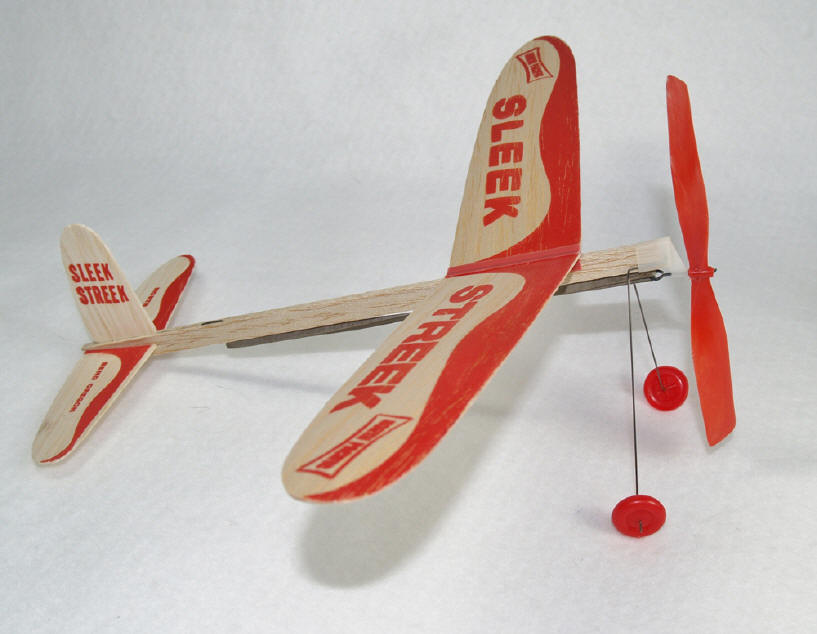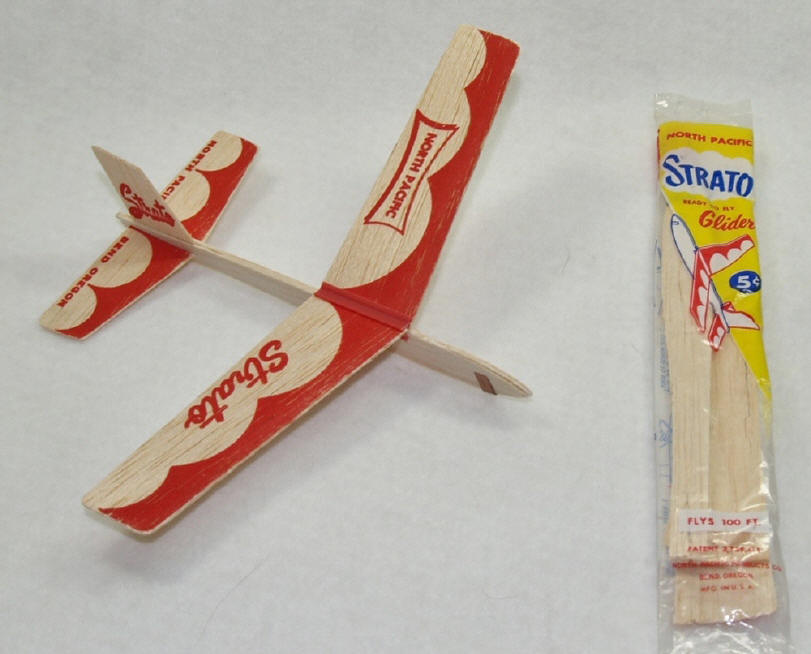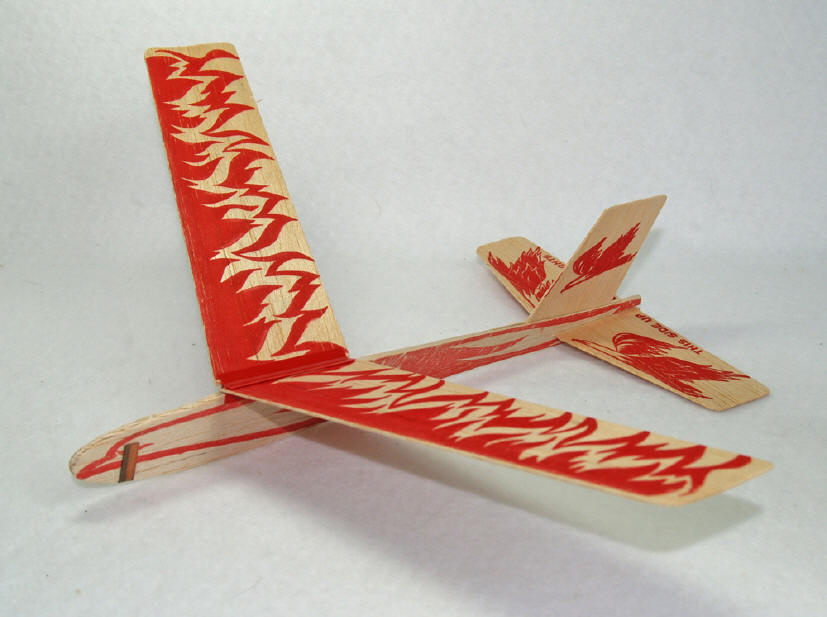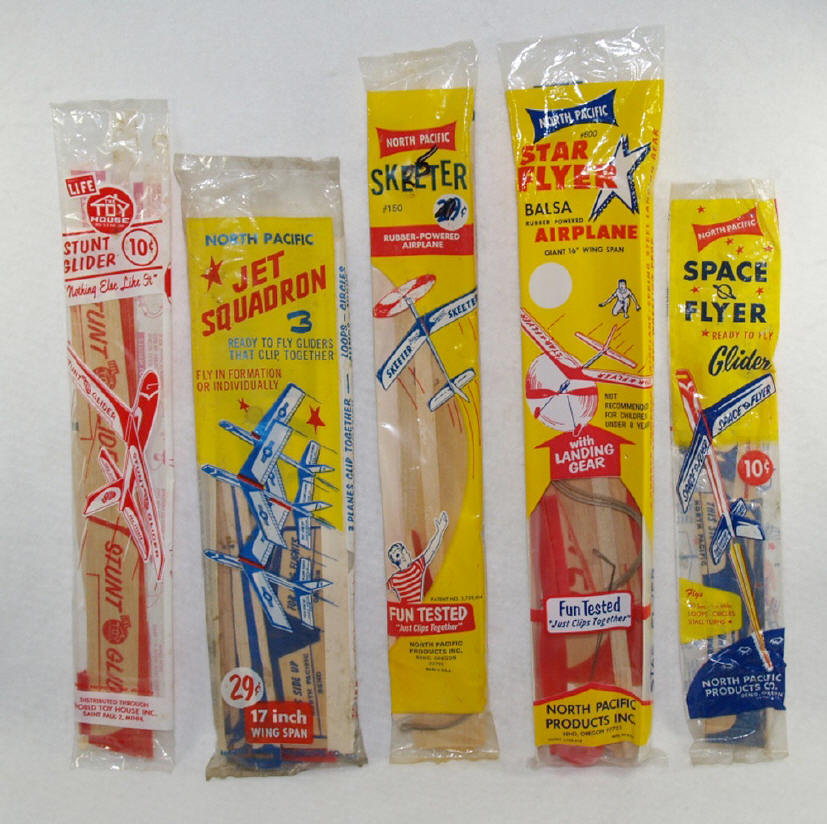All About Old Toys
|
|
North Pacific
Article by
Dave Pecota
|
North Pacific Products Co. During the period from the mid 1950’s to the mid 1970’s, North Pacific made some of the most popular (and best remembered) RTF airplanes. They were probably best known for their wide range of great performing ROG’s. The company was founded in Portland (OR) in 1952 by two brothers, Charles and Wally Cleveland. The Cleveland brothers worked at Jim Walker’s American Junior Aircraft Co from 1946-53. While still working at AJ … and reportedly without Walker’s knowledge … the brothers were also making and selling their own brand of gliders from their home. To reduce production costs, Walker wanted to take advantage of the wood curl generated by his company’s advanced balsa slicing machinery … especially during the wing-slicing process. He directed Charles to create a plastic clip that could quickly affix the sliced (and curled) wings onto the fuselages of smaller AJ gliders and ROG’s. This would allow the company to make airfoil wings for the lower-cost aircraft without using costly wing steaming equipment. Wally engineered a small extrusion machine at AJ to produce the plastic clip. Subsequently, the brothers quit American Junior and moved to Bend (OR) in 1954 to open a new factory subsidized by the city for their North Pacific Products brand. Walker felt the “battle lines” were drawn when NP started mass-producing gliders in Bend in direct competition to AJ, using similar wing clips and slicing machinery. Although the legal fees piled up and acrimony grew, both companies continued unabated in churning out airplanes using machine-sliced wings and plastic clips. (Virtually every NP RTF aircraft used the clip at the time.) It was during this period that Walker’s health steadily deteriorated. He passed away in 1958, before the legal issues could be totally resolved. Once Pactra Chemical Co absorbed AJ in 1963, Pactra withdrew further legal action as their interest steadily waned in keeping the AJ product line going. Legal issues notwithstanding, the Cleveland brothers developed several innovative gliders and ROG’s. Their designs were relatively easy to scale up and down, so the company was able to produce an extensive range of aircraft sizes with excellent flight performance … based only on a few basic designs. The light and elegant Sleek Streek ROG was probably the best performer in its class and is affectionately remembered by model airplane enthusiasts to this day. Likewise, the names Strato, Skeeter, Jet Flyer, Chuck’r and Astro Gnat will spark childhood memories in many of us. Due to the sagging public interest in wood gliders in the 1960’s, NP turned its attention away from gliders and ROGs. They patented a tail-less “gliding” kite design (“glite”) in 1966 and a wooden boomerang design in 1968. Both products went into production, but the company continued to struggle. By the early 1980’s, North Pacific had ceased operations completely and the company assets had been sold by its bank to the Comet Model & Supply Co. Comet in turn was purchased by the Paul K Guillow Company in 1998. |
|
“Sleek Streek” ROG (ca late 1950’s) – The model flying enthusiast’s favorite ROG in NP’s line-up was undoubtedly the Sleek Streek … produced from the early 1950’s into the 70’s. This example is probably an early version with its low 25 cent price. Its outstanding performance was credited to great wing stability, perfect balance and the remarkable efficiency of its propeller. A confirmed pilot report indicated a Streek was spotted cruising gracefully in a thermal at an altitude of 5,000 feet. |
|
“Jet Flyer” catapult glider (ca 1950’s) – In my opinion, this sleek jet was the best looking glider that NP ever made ... although it was just “average” with respect to flying performance. Cleverly, the wing clip was used to attach the wings to the bottom of the fuselage rather than the top, as was customary with most NP planes. The 1960’s version of the Jet Flyer (now called the Super Jet Flyer) “reversed” the graphics on the wings … simple blue lines on natural wood. But the overall design was unchanged.
|
|
“Strato” toss glider (ca 1950’s) – This tiny glider was a mainstay in NP’s product line for over two decades, without any significant design changes over that time. I learned the nuances of the NP wing clip by snapping the wings of my first few Stratos, while trying to jam the thin wings into the slots on the clip. (I don’t recall if I discovered the “pinch the clip base to open the slots” method of wing insertion myself or resorted to actually reading the directions on the package.) |
|
“Stunt-Flyer” toss glider (ca early 1960’s) – Reported to be the first glider NP made, the Stunt-Flyer was known for its long, smooth glides in light winds … a “floater” to be sure. This particular example was produced as a promotional item for “Firebird” gasoline made by the Pure Oil Co … and has some of the most spectacular graphics ever placed on a “toy” glider. |
|
“Hi Flyer” toss glider (ca late 1950’s) - One could argue whether the Hi Flyer really had the “right stuff” to be a true contest glider as indicated in the fuselage graphics. But the glider certainly was a “looker” and had excellent performance for a dime. It was also a prime example how successful the NP folks were at “scaling up” their designs. The Hi Flyer was a much larger iteration of the little Strato. |
|
“Sport Flyer” ROG (ca 1960’s) – The largest RTF aircraft in the NP line (to my knowledge), this enormous ROG towers over most NP gliders. I can’t vouch for its performance at this writing. It was much too expensive to purchase when I was a young pup and I currently have only this lone (un-flown) example in my collection. But someday, I may take it flying. |
|
|
|
“Astro Gnat” rubber-powered glider (ca 1960’s) – One of the smallest of NP’s powered gliders, the diminutive Gnat was known for its unusual multi-striped wing graphics. Truly, its namesake is not a creature held in very high esteem by those who have to tolerate its annoying presence. However, the name was a clever take-off on one of the new “outer space” words … astronaut … that burst onto the nation’s consciousness during this time. |




